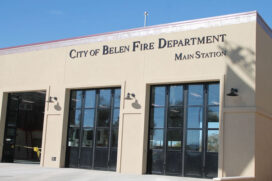It has been said, nothing in life is guaranteed except death and taxes.
While most people don’t contemplate their demise on a daily basis, taxes on the other hand are intertwined in our lives due to tasks such as buying a tank of gas or replacing a furnace.
The two most common types of taxes people encounter — gross receipts taxes and property taxes — are the ones that are the core revenue generators for local government services, such as law enforcement and fire departments as well as repairing roads and paying salaries.
Gross receipt taxes
Gross receipts taxes are collected on almost all goods and services sold or obtained in the state, with the exception of most groceries and medications. Many people refer to GRT as a “sales tax,” which is a bit of a distinction without a difference.
In states that collect a sales tax, sellers charge those taxes on top of their selling price. The customer pays the final price, which is the selling price plus sales taxes, and the seller reports and remits sales taxes they’ve collected on behalf of the state.
In New Mexico, the concept of a GRT is that a certain percentage of a seller’s total revenue, or gross receipts of each sale, has to be paid to the state as a tax. Sellers aren’t required to collect GRT from buyers, but most do instead of the seller paying GRT our of their earnings.
For instance, in the town of Peralta, the GRT is 7.9375 percent. If a retail store sells an item for $5, they then owe that percentage. Instead of subtracting the amount from the $5, they charge an additional 40 cents to the buyer, which is then paid to the state.
When GRT is sent to the New Mexico taxation and Revenue Department, 5.125 percent is kept and the remainder is disbursed back to the originating jurisdiction.
Many times a municipality or county will enact a GRT to fund a specific expense, such as a solid waste program or a dispatch center, or it simply goes into the general fund and is used to pay operational costs, such as salaries and monthly bills.
Since most retail businesses tend to be concentrated in municipalities, rather than in unincorporated areas of a county, GRT revenues are critical to municipal budgets. While municipalities only have authority to tax within their jurisdiction, a county commission can impose a GRT on the entire county or only in unincorporated areas outside a municipality.
GRT rates vary from jurisdiction to jurisdiction, depending on what portions have been enacted.
Property tax
While anyone who buys goods or contracts for services is subject to paying GRT, another common tax — property taxes — only effects those who actually own property, whether it’s a home, business or agricultural land.
With the exception of property owned by a public entity, such as a school district or city, nearly all other property owners must pay taxes according to the valuation of the property.
The more valuable a property is, the more the owner will pay in taxes, but taxes aren’t collected on the whole value. After the county assessor determines the appraised value of a property, that value is divided by three, which is the taxable value.
So for instance, a property appraised at $150,000 has a taxable value of $50,000. Owners can also apply what are called exemptions to lower their tax bill, such as a head of household value, which lowers the taxable value by $2,000 or a veterans exemption, which knocks off $6,000.
So that property with a taxable value of $50,000 would have a next taxable value of $44,000 after those two exemptions were applied, for instance, resulting in a property tax bill of $1,597.68.
The property taxes collected by Valencia County is divided up among several agencies — the state, the municipality the property is located in, either the Belen or Los Lunas school district, The University of New Mexico-Valencia campus, Valencia Soil and Water Conservancy and, if the property is in the benefited area, the Middle Rio Grande Conservancy District.
The county collects more $24 million in property taxes annually, 30 percent of which goes to Valencia County to provide services for residents. Much like municipalities rely on GRT for the bulk of their revenue, counties bank on healthy property tax revenues.
General obligation bonds
Property tax revenues are also used to pay for general obligation bonds approved by the public. GO bonds allow an agency to borrow money for large, capital improvement projects, such as fire stations and major road projects.
These bonds are dedicated to specific projects and voted for by the community. If a GO bond is approved in a community, then principal and interest on the bonds are paid for out of property taxes.
Recently completed bond projects include the new Rio Grande Elementary, the Belen High School Natatorium for the Belen Consolidated Schools, and brand new fire stations in Belen and Los Lunas.
School district capital funding
School districts can ask taxpayers in their jurisdiction to approve GO bonds, but they also receive an ongoing revenue stream from property taxes that is used for maintenance and repair of facilities.
Commonly referred to as SB9 funding — in reference to the enabling legislation passed decades ago by the state Legislature — the money collected can be used to make repairs, help pay for construction costs of new buildings, purchase vehicles to transport students, such as activity buses, buy computer hardware and software that will be directly used by students, make education technology improvements, such as networking and digital communication equipment.
The Belen Consolidated Schools budgeted for SB9 revenues at $1,263,610 for this current school year. Within its budget, the district has divided that money into four broad categories — maintenance and repair, construction, software and technology, and supplies and material.
The key to SB9 funds is to maintain a balance between planned projects and unexpected needs, such as windows broken in a storm. Any planned projects are guided by the district’s facilities master plan, which includes projects such as replacing entire buildings to reroofing a gymnasium.
Within that plan, SB9 can be used to pay for part of or all of a project, depending on total cost.
The Valencia County News-Bulletin is a locally owned and operated community newspaper, dedicated to serving Valencia County since 1910 through the highest journalistic and professional business standards. The VCNB is published weekly on Thursdays, including holidays both in print and online.

















